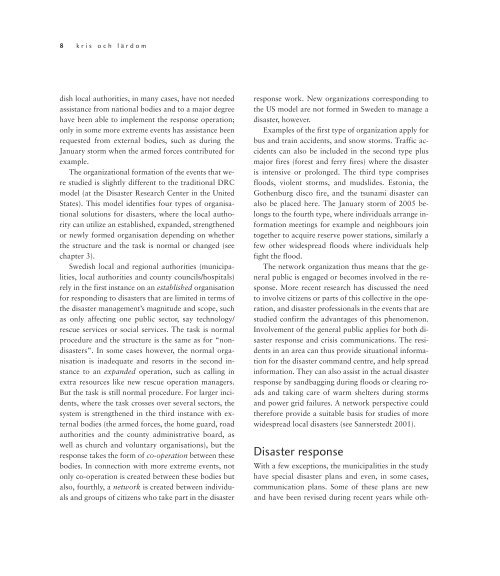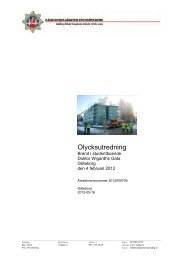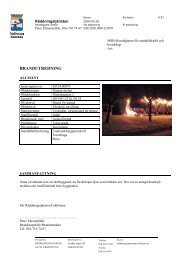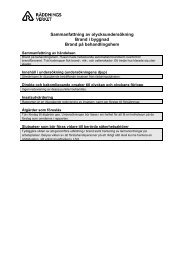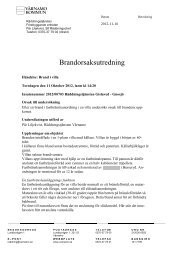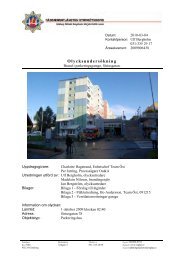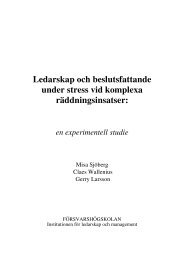Sverige
Sverige
Sverige
You also want an ePaper? Increase the reach of your titles
YUMPU automatically turns print PDFs into web optimized ePapers that Google loves.
8 kris och lärdom<br />
dish local authorities, in many cases, have not needed<br />
assistance from national bodies and to a major degree<br />
have been able to implement the response operation;<br />
only in some more extreme events has assistance been<br />
requested from external bodies, such as during the<br />
January storm when the armed forces contributed for<br />
example.<br />
The organizational formation of the events that were<br />
studied is slightly different to the traditional DRC<br />
model (at the Disaster Research Center in the United<br />
States). This model identifies four types of organisational<br />
solutions for disasters, where the local authority<br />
can utilize an established, expanded, strengthened<br />
or newly formed organisation depending on whether<br />
the structure and the task is normal or changed (see<br />
chapter 3).<br />
Swedish local and regional authorities (municipalities,<br />
local authorities and county councils/hospitals)<br />
rely in the first instance on an established organisation<br />
for responding to disasters that are limited in terms of<br />
the disaster management’s magnitude and scope, such<br />
as only affecting one public sector, say technology/<br />
rescue services or social services. The task is normal<br />
procedure and the structure is the same as for “nondisasters”.<br />
In some cases however, the normal organisation<br />
is inadequate and resorts in the second instance<br />
to an expanded operation, such as calling in<br />
extra resources like new rescue operation managers.<br />
But the task is still normal procedure. For larger incidents,<br />
where the task crosses over several sectors, the<br />
system is strengthened in the third instance with external<br />
bodies (the armed forces, the home guard, road<br />
authorities and the county administrative board, as<br />
well as church and voluntary organisations), but the<br />
response takes the form of co-operation between these<br />
bodies. In connection with more extreme events, not<br />
only co-operation is created between these bodies but<br />
also, fourthly, a network is created between individuals<br />
and groups of citizens who take part in the disaster<br />
response work. New organizations corresponding to<br />
the US model are not formed in Sweden to manage a<br />
disaster, however.<br />
Examples of the first type of organization apply for<br />
bus and train accidents, and snow storms. Traffic accidents<br />
can also be included in the second type plus<br />
major fires (forest and ferry fires) where the disaster<br />
is intensive or prolonged. The third type comprises<br />
floods, violent storms, and mudslides. Estonia, the<br />
Gothenburg disco fire, and the tsunami disaster can<br />
also be placed here. The January storm of 2005 belongs<br />
to the fourth type, where individuals arrange information<br />
meetings for example and neighbours join<br />
together to acquire reserve power stations, similarly a<br />
few other widespread floods where individuals help<br />
fight the flood.<br />
The network organization thus means that the general<br />
public is engaged or becomes involved in the response.<br />
More recent research has discussed the need<br />
to involve citizens or parts of this collective in the operation,<br />
and disaster professionals in the events that are<br />
studied confirm the advantages of this phenomenon.<br />
Involvement of the general public applies for both disaster<br />
response and crisis communications. The residents<br />
in an area can thus provide situational information<br />
for the disaster command centre, and help spread<br />
information. They can also assist in the actual disaster<br />
response by sandbagging during floods or clearing roads<br />
and taking care of warm shelters during storms<br />
and power grid failures. A network perspective could<br />
therefore provide a suitable basis for studies of more<br />
widespread local disasters (see Sannerstedt 2001).<br />
Disaster response<br />
With a few exceptions, the municipalities in the study<br />
have special disaster plans and even, in some cases,<br />
communication plans. Some of these plans are new<br />
and have been revised during recent years while oth-


